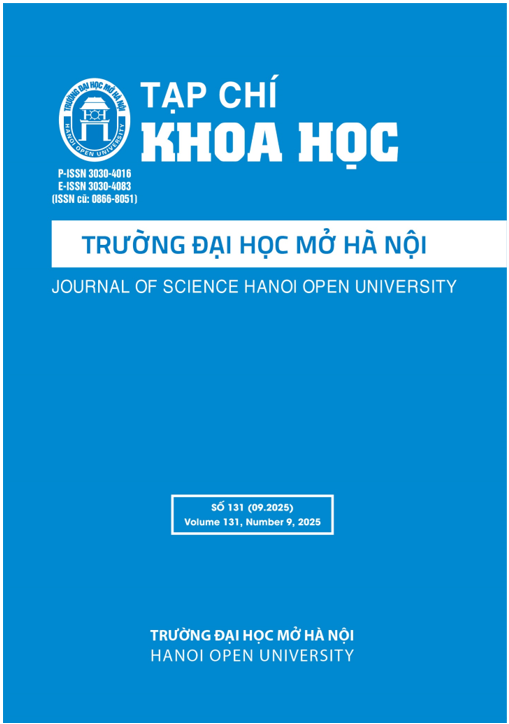THE EFFECTIVENESS OF KAHOOT! IN IMPROVING VOCABULARY FOR FIRST-YEAR ENGLISH MAJORS: A CASE STUDY AT A PUBLIC UNIVERSITY IN HANOI
DOI:
https://doi.org/10.59266/houjs.2025.753Từ khóa:
vocabulary, vocabulary learning, game-based learning tools, Kahoot!Tóm tắt
This study was conducted to (1) discover the difficulties faced by first-year students at the Faculty of English of a public university in Hanoi when learning and memorizing vocabulary, and (2) evaluate the effectiveness of using Kahoot! in improving students' vocabulary. The participants included 161 first-year English majors. A mixed method was employed, with research instruments including a questionnaire, vocabulary tests (pre-test and post-test), and interviews. The findings revealed that participants encountered obstacles, including memorizing vocabulary in the long term, using the correct words in context, not having enough time to practice, and having low motivation. In terms of using Kahoot! for vocabulary learning, the experimental group scored higher on the post-test than the control group, demonstrating that Kahoot! is an effective resource for improving vocabulary acquisition and retention. Interviews with the experiment further confirmed that Kahoot! is engaging and beneficial. In general, the results support the integration of game-based learning tools to improve vocabulary learning.
Tài liệu tham khảo
[1]. Bicen, H., & Kocakoyun, S. (2018). Perceptions of Students for Gamification Approach: Kahoot! as a Case Study. International Journal of Emerging Technologies in Learning, 13(02), 72-93.
[2]. Hornby, A. S. (2005). Oxford Advanced Learner’s Dictionary of Current English (7th ed.). Oxford University Press.
[3]. Hulstijn, J. H. (1997). Mnemonic methods in foreign language vocabulary learning: Theoretical considerations and pedagogical implications. In J. Coady, & E. Huckin (Eds.), Second Language Vocabulary Acquisition: A Rationale for Pedagogy (pp. 203-224). Cambridge University Press.
[4]. Ismail, N. S., Zaid, S. B., Mohamed, M. H., & Rouyan, N. M. (2017). Vocabulary teaching and learning principles in classroom practices. Arab World English Journal (AWEJ), 8(3), 119-134. DOI: https://dx.doi.org/10.24093/awej/vol8no3.9
[5]. Jácome, V., Espinoza, S., & Andraus, C. (2025). AI-powered digital tools for vocabulary retention in Foreign Language Learners: A perception-based study. Revista San Gregorio, 1(62), 79-84. http://dx.doi.org/10.36097/rsan. v1i62.3579
[6]. Long, M. H. (1996). The role of the linguistic environment in second language acquisition. In W. C. Ritchie & T. K. Bhatia (Eds.), Handbook of second language acquisition (pp. 413- 468). Academic Press.
[7]. Nation, I. S. P. (2001). Learning vocabulary in another language. Cambridge University Press.
[8]. Oxford, R., & Scarcella, R. (1994). Second language vocabulary learning among adults: State of the art in vocabulary instruction. System, 22(2), 231-243.
[9]. Plass, J. L., Homer, B. D., & Kinzer, C. K. (2015). Foundations of game-based learning. Educational Psychologist, 50(4), 258-283.
[10]. Plump, C. M., & LaRosa, J. (2017). Using Kahoot! in the classroom to create engagement and active learning: A game-based technology solution for eLearning novices. Management Teaching Review, 2(2), 151-158.
[11]. Richards, J.C. (1976). The role of vocabulary teaching. TESOL Quarterly, (10), 77-89.
[12]. Saksittanupab, P. (2024). Enhancing Vocabulary Acquisition and Retention: The Role of Spaced Repetition in Language Learning. Journal of Modern Learning Development, 9(5), 205-215. retrieved from https://so06.tci- thaijo.org/index.php/jomld/article/ view/273598
[13]. Schmitt, N. (2000). Vocabulary in Language Teaching. Cambridge University Press
[14]. Schmitt, N. (2008). Review article: Instructed second language vocabulary learning. Language Teaching Research, 12(3), 329-363.
[15]. Schmitt, N. (2010). Researching vocabulary: A vocabulary research manual. Palgrave Macmillan.
[16]. Susanto, A. (2017). The teaching of vocabulary: A perspective. Journal KATA, 1(2), 182-191.
[17]. Pham, N. T., & Duong, T. D. (2022). Using Kahoot! In vocabulary learning: Evidence from a Vietnamese higher education context. VNU Journal of Foreign Studies, 38(3).
[18]. Ur, P. (1996). A course in Language Teaching: Practice and Theory. Cambridge University Press.
[19]. Wang, A. I. (2015). The wear-out effect of a game-based student response system. Computers & Education, 82, 217-227.
